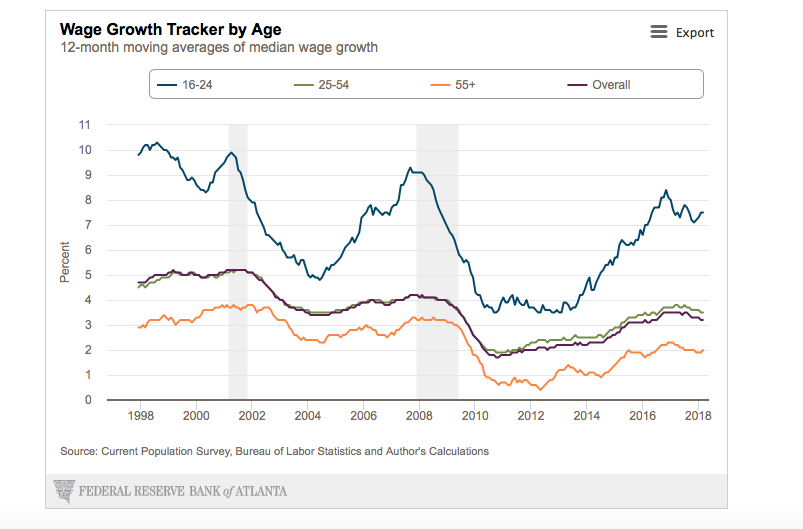
by Kate Evert | May 30, 2018 | Compensation, Economy, Wage Increases
Two summers ago, we posted an article, “
Is the Economy Getting Better Or Worse?” Still perplexed, this year, we’re hearing from the Kansas City Fed. They strike a cautionary note that if 14.3% of workers haven’t received a raise in the last year, then there aren’t true pressures on wages, and therefore no concerns about inflation, and no need to raise interest rates. QED.
Not so fast. Let us return to the thought process that geometry proofs taught us:
If 14.3% of workers did not receive a wage increase, 85.7% did. Drop to the median, not of the triangle, but of the same Fed statistics. The median wage increase in April was 3.3% and the 75th percentile increase of 13.9%. That delta is 10.6%
So the real question is: Who are the 14.3%? Are they people in jobs that the market no longer rewards? Are they people who have been making at market, or higher, for many years and therefore their employers cannot justify an increase? Are they employees who have not acquired new skills and therefore are stagnated in roles and cannot get a raise? Do they work for companies that are facing economic challenges and doing their best to keep their doors open in the US? Or are keeping wages low but providing benefits?
We, of course, do not have the answers to the questions underlying the 14.3%, but we feel that the focus should be on the reciprocal, the 85.7% … and especially the 13.9%. Where they live and what they do – the intersections of those planes will have far more to do with inflation.
Read More Here.

by Kate Evert | May 30, 2018 | Compensation, Economy, Wage Increases
Two summers ago, we posted an article, “
Is the Economy Getting Better Or Worse?” Still perplexed, this year, we’re hearing from the Kansas City Fed. They strike a cautionary note that if 14.3% of workers haven’t received a raise in the last year, then there aren’t true pressures on wages, and therefore no concerns about inflation, and no need to raise interest rates. QED.
Not so fast. Let us return to the thought process that geometry proofs taught us:
If 14.3% of workers did not receive a wage increase, 85.7% did. Drop to the median, not of the triangle, but of the same Fed statistics. The median wage increase in April was 3.3% and the 75th percentile increase of 13.9%. That delta is 10.6%
So the real question is: Who are the 14.3%? Are they people in jobs that the market no longer rewards? Are they people who have been making at market, or higher, for many years and therefore their employers cannot justify an increase? Are they employees who have not acquired new skills and therefore are stagnated in roles and cannot get a raise? Do they work for companies that are facing economic challenges and doing their best to keep their doors open in the US? Or are keeping wages low but providing benefits?
We, of course, do not have the answers to the questions underlying the 14.3%, but we feel that the focus should be on the reciprocal, the 85.7% … and especially the 13.9%. Where they live and what they do – the intersections of those planes will have far more to do with inflation.
Read More Here.

by Kate Evert | May 2, 2018 | Labor Markets, Skilled Labor
You may have seen the article in Monday’s WSJ that spoke about towns and companies enticing younger people to move with $5,000 to help pay student loans or pay for a house. Mike Allgrunn, an economist at the University of South Dakota, dubs these “a modern-day Homestead Act.”
From the above graph, courtesy of the Atlanta Fed, you can see the one demographic driving higher wages: youth. Run this graph through its various iterations: education, race, and census division; none of these statistical parsings come close to showing the large wage difference for just being young. Why? Because we have a shortage of young workers. Especially young, skilled workers. Here’s another great article from Reuters. Read More Here

by Kate Evert | Apr 17, 2018 | Compensation, Diversity, Equity, Inclusion, Human Capital, Work Place
If you haven’t seen our latest post, Read More Here, we highlighted a recent study about the earnings gap that some working mothers experience after the birth of a child. The study’s findings suggest that depending on the arrival of that first child, some women’s earnings will never recover. We happen to think that a great deal of these mothers chose alternate paths, and paths that often benefit other parents looking for flexibility. If you’re in Virginia, check out this new company, Play, Work, or Dash. Their co-working space offers more than just a space to work. They’re branching out and offering childcare services. A future trend we might see more of? We sure hope so. Another idea we wish we had thought of first. Read More Here.

by Kate Evert | Apr 12, 2018 | Compensation, Diversity, Equity, Inclusion, Salary Budgets, Wage Increases, Work Place
I had no hesitation about becoming a working mother. But reading this article brought back a memory that I must have blocked – until now.
Just about 21 years ago, when awaiting the birth of our first child, I encountered a female partner at the elevator bank. Now given that the Partner-in-Charge of our National group practice was a mother, the Partner-in-Charge of our Chicago practice was a mother, and I had two supportive bosses who were both fathers, I was not unduly worried about becoming a working mother.
Imagine my surprise when this female partner asked me how was I going to “manage coming back to work” after the birth of my child? I thought it was the oddest of questions to ask in our practice area, but despite my surprise, answered her anyway. So imagine my shock when she responded, “Well I sure hope your husband makes a lot of money; that will be expensive.” Now given that we worked in Global Human Resources Solutions, this response was so wrong on so many levels. But even way back in 1997, I found the notion that my career plans were going to be entirely dependent on the earning power of my husband completely absurd.
Sadly, this article shows that perhaps that notion wasn’t so absurd. Our daughter turns 21 this month. I just hope and pray that this notion changes in time for her. Read More Here






